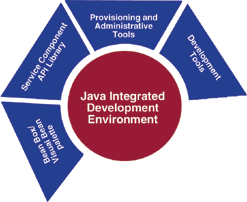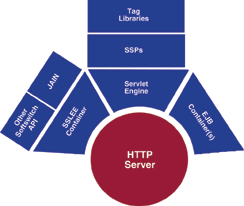|
In the telecommunications world, "service creation" has
meant programming specialized services such as 800
numbers, call waiting, and call forwarding, that are to
be delivered to users over the public switched telephone
network (PSTN). But the Internet and Web-based access
technologies have expanded the term to cover a growing
array of new data services, such as customized content
delivery, Web conferencing, and instant messaging. For
developers, the twains are now meeting.
Bridging service creation in these parallel universes
calls for a new generation of service creation
environments (SCEs) that have the goal of providing
rapid application-development environments in which
developers can pick design methodology, and where
reliable and sophisticated applications can be built
with minimal effort.
A market consensus is fast emerging that the most
versatile development kid on the block, capable of
adequately serving these two networking masters, is the
Java programming language as the basis for new-gen SCEs.
In fact, with its appealing "write once-run anywhere"
capability, Java readily meets the basic requirements
for such new-gen SCEs for telecommunications services:
- Easy to use and capable of handling a large user
base;
- Takes advantage of the latest software development
concepts;
- Object-oriented with a standard methodology for
creating software components;
- Currently in use to develop Web-based
technologies;
- Has defined (or is defining) standard APIs to
connect to other networks or network protocols, such
as SS7, Megaco, or SIP;
- Allows developed applications to be ported to a
wide variety of systems; and
- Provides a graphical-based programming environment
to aid in using components and speed service
development.
Historical Perspective
Designed by Sun Microsystems in 1991 as an interpreted
language for generating applications able to run on all
hardware platforms without modification, Java was
initially developed for embedded applications such as
set-top boxes. It was transitioned to the Web by 1994.
Now it also is efficiently filling the bill as the
latest tool in a long history of service creation
application generators (AppGens) for the
telecommunications/telephony field.
Historically, the purpose of telecom AppGens was to
reduce programming drudgery by enabling developers to
draw applications using common functions (such as
playing a voice prompt or collecting DTMF digits)
represented as graphical components. This was similar to
digital electronics engineers using schematic-capture
programs. The developer would connect components in the
graphical environment, thus speeding up the development
time and providing a visual representation of the
program logic.
Earlier AppGens generated a proprietary scripting
language which a corresponding run-time engine then
interpreted. It worked, but suffered from performance
problems. As a result, the output format of these
AppGens was changed to produce a jump table. This method
stripped out character strings and replaced them with
jump-table references, allowing the run-time environment
to look up a function call in a function table. While
performance improved, the output of the AppGens became
unintelligible.
So telecom AppGens developers embraced the then new
kid on the block, Visual Basic (VB), a development
environment that was used for actual development and
generated real code that could then be further modified.
Unfortunately, it collared the developer to a specific
hardware platform. These environments also found
developers hitting "the wall" when they needed more than
the library of components could provide, and adding new
functionality was so cumbersome that it often was easier
to revert to writing code by hand than use the graphical
environment.
Telecom Demands
The ever-changing world of telecommunications equipment
has spawned a plethora of operating environments, from
RTOSs to full-blown operating systems such as Solaris.
Any service-creation AppGen, therefore, must allow for
rapid application development as well as have the
ability to run on a wide variety of hardware and
operating systems. Java has become the premier way to
provide a needed "write once-run anywhere" environment.
Because Java is transportable across multiple platforms
and operating systems, a developer can be reasonably
assured that changing hardware environments will not
compromise their run-time environment.
Using Java as the foundation of a next-generation
execution environment means developers can take
advantage of what Java affords. Unlike other languages
such as its progenitor C/C++, for example, Java eases
the burden of developing applications by using tools
such as its often-maligned Garbage Collection feature.
C++ developers can spend weeks working an application�s
memory-management infrastructure. Even learning the
in-house memory management application programming
interfaces (APIs) and using them correctly can be time
consuming. With Java, developers can let references go
out of scope and simply allow the underlying JVM to
garbage collect the unused references.
Standard APIs
Standard frameworks and design patterns are essential
for developing flexible, portable applications, and Java
makes an extensive array of both available as openly
defined libraries. The Java Media Framework (JMF), for
instance, is an extensible API for dealing with playing
and recording sound files. The JMF can be extended to
abstract most integrated voice response functions found
in telecom applications.
JMF plays a central role, for example, in many of the
voice-over-IP scenarios. This is due in part to the ease
of programming, but also because Realtime Transport
Protocol (RTP) is provided in the reference
implementation of JMF. While RTP tools are freely
available for C++ users, there are no standard APIs
defined, which makes providing a solution far more
difficult.
In fact, there are Java APIs defined for almost every
conceivable facet of software development. Most are
covered under the Java Community Process, an open
development site maintained by Sun with a process
defined for introducing new APIs into the Java language.
This is where the JAIN initiative (Java APIs for
Integrated Networks) defines APIs for many of the
converged network protocols in use today. The SS7 ISUP
and TCAP JAIN specifications, for instance, are
available to the public, with others in the early stages
of definition.
As the new standards are made public and gain wide
usage, they will provide the foundation for creating
services that span multiple networks. Again, the goal
for the new-generation SCEs is to create a rapid
application development in which reliable applications
can be built with minimal effort on the part of the
developer. Java is the one environment that delivers all
the necessary components.
Java Fits
Telecom services are event driven at their core. Java,
as an object-oriented language, is predisposed to
handling events in an intuitive manner. JavaBeans, the
standard component specification for Java, defines a
standard way to relate events to method or function
calls. JavaBeans help encapsulate the run-time
functionality into a set of easily understood components
(beans) which naturally enforce code reuse by
programming teams. The software engineering principle of
"reuse" is the key to expediting the development
process, and JavaBeans fully support this principle.
What Should The Service Creation Environment Look
Like?
A standard "Commercial Off The Shelf Java Integrated
Development Environment" is a big revelation and a big
responsibility of the runtime environment provider.
To create a service, a developer uses off-the-shelf
Java Integrated Development Environments (IDEs), the
same tools Java developers have used to create countless
Web-based applications. The model follows a specific
pattern: First create the set of applications that work
together to provide the service; then deploy the service
by packaging it in a jar file; then deliver it to the
run-time environment to be executed. "Create, deploy,
and execute" is the mantra of service development.
| Figure
1. The SCE Architecture |
Figure
2. The SRE Container |
 |
 |
|
Click
figures to enlarge. |
The SCE architecture is centered around a Java IDE (Figure
1). Any SCE must allow Web-application paradigms to
be used within a telecom environment. Old telecom
paradigms took time to learn and time to develop any
application. Because the SCE is based on Java and many
of its standard APIs, there is a wealth of books and
magazines available to create training materials for new
programmers, saving time because the development team
need not document the internal process of development.
A complete service creation environment is more than
just an IDE. The Service Runtime Environment (SRE),
where all the complexity and connectivity are
abstracted, turns the IDE into a service creation
environment. The APIs exposed by the SRE and made
available in the IDE is the simplifying technology
necessary to make the service itself easier to develop.
At its core, the SRE makes use of a Web application
server thus providing access to Web-based technologies
such as servlets, JSPs, and EJBs. Added to this
infrastructure is a SRE container
(Figure 2). The SRE container
abstracts the underlying protocols used for processing
phone calls. It also handles the threading of each of
the service instances. Threading is important for the
container to manage because it simplifies the structure
of the service. By handling the interface to the
telecommunications infrastructure, the SRE container
allows services to span multiple networks and to take
advantage of truly converged networks. This is where
instant messaging meets the PSTN.
Futureproof Java
Service creation and service execution go hand-in-hand,
and Java enables creation of a holistic environment
where developers can use the same language to create
both applications and the run-time environment they
deploy to. And it is flexible. In the technology
outlined above, for instance, XML can be used easily as
a distributed protocol. For example, a service developed
may need to control a VXML server to control
speech-enabled technology on a separate server. With the
Java API for XML Processing (JAXP), XML data languages
can be generated and/or interpreted.
A next-generation service creation environment needs
to be versatile, and the best way to insure that is by
choosing an environment that is used for developing a
wide variety of applications. Java even provides a
native interface where developers can access C/C++
libraries and programs provided on the underlying
operating system. All of this technology helps keep
applications on the cutting edge. When a new protocol
comes along or a new device hits the market, the
developer will always have a method of integrating new
technology into the development environment.
As applications become ever more complex, a properly
designed service creation/service run-time environment
using Java will enable developers to build highly
reliable new telecommunications services within shorter
development cycles. It will also make it possible for
service providers to test-market a multitude of new
services by minimizing the upfront hurdles to new
service creation and deployment.
Tom McGuire is senior director of Service Creation
and Systems Integration, Pelago
Networks. Pelago Networks is focused on overcoming
the challenges facing service providers such as
established local exchange carriers (LECs), CLECs and
next-generation ICPs, in delivering enhanced
communications services to business customers over any
wireless or wireline broadband access network.
[ Return
To The October 2001 Table Of Contents ]
|

